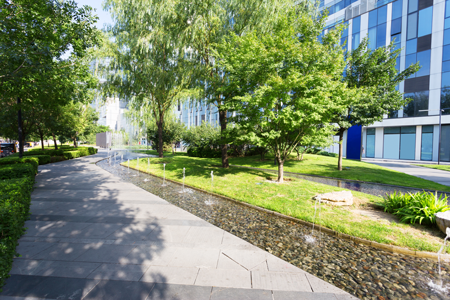

Sustainable design. Green building. Eco architecture.
Whatever name you want to call it, sustainable design is a growing trend in the building industry.
By reducing consumption of non-renewable resources, minimizing waste, and creating healthy, productive environments, sustainable design practices seek to improve building performance and reduce negative impacts on the environment and the health and comfort of building occupants.
Based on the rates that buildings use and consume resources, sustainable design can play a significant role in overall environmental conservation efforts. According to the Environmental Protection Agency, buildings account for the following levels of energy use and consumption in the United States:
Based on these figures alone, it is easy to see the significant impact that buildings have on the natural environment, human health, and the economy. Green strategies can maximize a building’s environmental performance and deliver cost savings to the owner.
Green construction methods can be incorporated into a building at any point between design, construction, renovation, or destruction. Peter Basso Associates has a thorough understanding of system designs that incorporate alternative energy and energy conservation technologies.
As noted by the U.S. General Services Administration, sustainable design practices include the ability to:
So let’s take a look at how sustainable design practices address each of these issues, and how incorporating sustainable design efforts into your building can make it more eco-friendly and cost-effective.
Proper site selection is the first step in designing and creating sustainable buildings. A number of factors, including the building’s location, orientation, and landscaping, will affect local ecosystems, transportation, and energy consumption.
Another factor to consider in the sustainable design process is water consumption and runoff management. A building site should reduce, control, and/or treat storm water runoff and should attempt to reduce water use through effective landscape design.
Infrastructure design also plays a significant role in optimizing a site’s potential. Locations of access road, parking, vehicle barriers, and perimeter lighting all affect a local ecosystem and can impact the amount of energy and transportation that occupants and visitors will use.
In order to minimize the amount of non-renewable energy that a building will use, sustainable design practices will seek to incorporate alternative energy and energy conservation techniques to cut down on energy supplied by fossil fuels that a building will use.
Wind, solar, and geothermal sources can provide significant cost savings and lessen a building’s carbon footprint. Designers need to optimize the site for these renewable sources, making sure solar panels receive adequate daylight and wind turbines have access to consistent wind, for example.
There are a number of ways buildings can be designed to reduce their energy consumption, which will be discussed more in-depth in a later blog, but they can include energy-efficient lighting design, properly maintained HVAC systems, and daylighting.
Sustainable design seeks to use and reuse materials that will be the most productive and sustainable across its entire lifecycle, meaning that materials recycled from other buildings or projects, can be made/harvested in environmentally-friendly manners, and/or should be as reliable as possible in order to prevent added waste from frequent replacements.
Sustainable materials can minimize life-cycle environmental impacts such as global warming, resource depletion, and human toxicity. These materials can also boost the health and safety of building occupants.
A sustainable building should be able to use water efficiently, whether it is reusing or recycling water for on-site use or minimizing initial water use. A number of innovative practices can help a building conserve water, including installing low-flow toilets and faucets, utilizing greywater systems to recycle water for toilet flushing or irrigation purposes, or optimizing heating and cooling systems to ensure they aren’t using more water than is necessary.
The indoor environmental quality of a building can have a significant impact on occupant health, comfort and productivity. A sustainable building will maximize the amount of daylight present inside a building, which not only lowers energy costs, but boosts the mood and productivity of its occupants. Ventilation and moisture control will remove odors and airborne pathogens, increasing the overall indoor air quality and leading to healthier occupants.
Sustainable designers can identify materials and systems that will require less water, energy, and toxic chemicals and cleaners to maintain. They can customize these systems in order to ensure the best fit for the building, and ensure that maintenance requirements remain simple. Sustainable facilities will often include meters that track the progress of sustainability initiatives, leading to processes that are economical and reduce life-cycle costs.
Commissioning is the quality assurance process that begins during design and continues through construction, occupancy, and operations. The process ensures that building systems are designed, installed, and tested to operate as the owner intended and that building staff are prepared to operate and maintain its systems and equipment.
Engineering teams like those at PBA, can apply the commissioning process to new designs, and even older buildings, in order to make sure your building is providing you the optimal levels of energy efficiency and environmentally-friendly practices.
The commissioning process is essential to making sure your building meets LEED and sustainability standards. Get your free copy of our Building Commissioning Playbook to learn more about the many benefits commissioning can provide your building.
These Stories on Commissioning